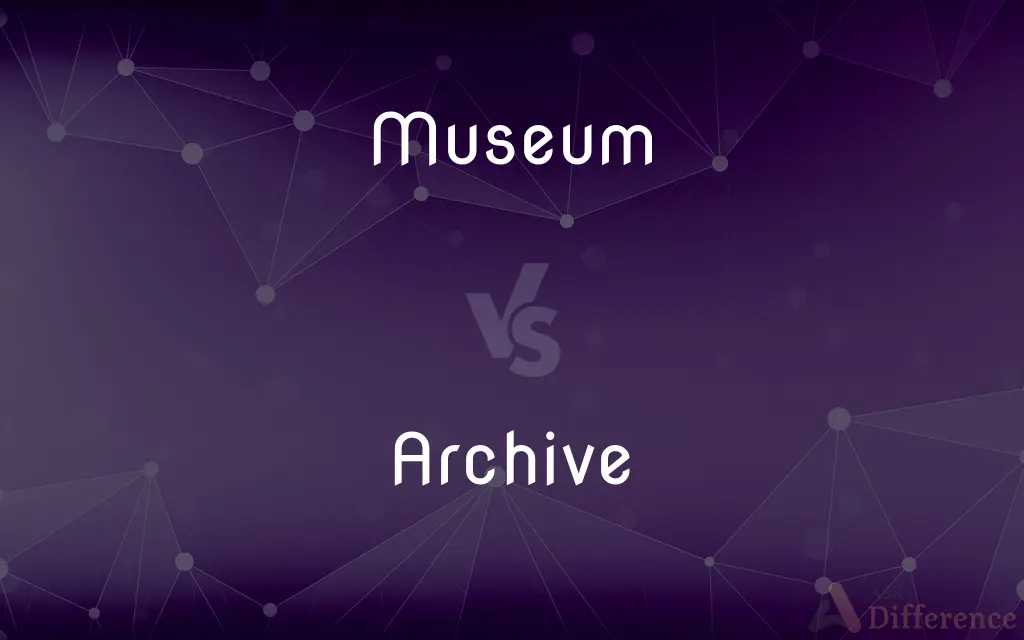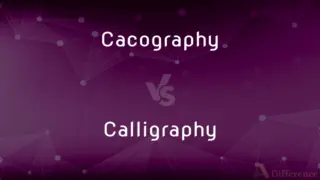Museum vs. Archive — What's the Difference?
By Tayyaba Rehman & Maham Liaqat — Updated on April 6, 2024
A museum displays artifacts and works of art, while an archive stores documents and records.

Difference Between Museum and Archive
Table of Contents
ADVERTISEMENT
Key Differences
Museums and archives are both institutions dedicated to the preservation of history, but they serve different purposes and cater to different types of collections. Museums focus on the exhibition of physical artifacts, art, and items of cultural, historical, or scientific significance, allowing the public to view and learn from them. Archives, on the other hand, specialize in the collection and preservation of documents, records, and other materials that have informational value, often serving as resources for research.
While museums provide educational and cultural experiences through exhibitions and displays, archives offer a more research-oriented environment. Archives are crucial for historians, researchers, and scholars, providing access to original documents, letters, reports, and other primary sources that are vital for academic and historical research. Museums, while they also educate, do so in a more general manner, catering to a broader audience through curated exhibits that tell stories or showcase artistic achievements.
The management and organization of collections within museums and archives also differ. Museums often categorize their collections based on type, era, or theme, focusing on the aesthetic and educational presentation of items. Archives organize their holdings in a way that maintains the original context of the documents or records, often arranged according to their source or creator, to preserve the integrity and usefulness of the information they contain.
Another key difference lies in the type of professionals who work in these institutions. Museums employ curators, educators, conservators, and exhibit designers, who work together to create engaging and informative displays. Archives are typically staffed by archivists and records managers, professionals trained in the principles of archival science, including the acquisition, management, and preservation of documents and records with long-term value.
The role of digital technology has also impacted both museums and archives, though in different ways. Museums use technology to enhance the visitor experience, through interactive exhibits and virtual tours, while archives use digital platforms primarily for the digitization and online accessibility of their collections, making them available to a wider audience for research purposes.
ADVERTISEMENT
Comparison Chart
Primary Focus
Display of artifacts, art, and items of significance
Storage and preservation of documents and records
Purpose
Education and cultural experience
Research and historical documentation
Audience
General public, tourists, students
Researchers, historians, scholars
Collection Types
Artifacts, paintings, sculptures, historical objects
Documents, letters, reports, electronic records
Organization
Categorized by type, era, theme
Arranged by source or creator to preserve context
Professional Roles
Curators, educators, conservators, exhibit designers
Archivists, records managers
Compare with Definitions
Museum
Institutions that may also conduct research related to their collections.
The natural history museum conducts research in paleontology.
Archive
Organizations that ensure the longevity and accessibility of digital records.
The digital archive offers access to electronic records and documents.
Museum
An institution dedicated to the preservation and public display of collections.
The local history museum showcases the town's heritage.
Archive
A repository for historical documents and records.
The National Archives houses original copies of significant historical documents.
Museum
A place for learning and inspiration through physical exhibits.
Children's museums provide interactive learning experiences.
Archive
An institution focused on the collection and preservation of primary sources.
The university archive maintains a vast collection of personal papers from notable alumni.
Museum
A building or space for the exhibition of artistic, historical, or scientific artifacts.
The Smithsonian is a museum that attracts millions of visitors each year.
Archive
Facilities that might specialize in specific types of records.
The film archive preserves classic and contemporary films.
Museum
Facilities that organize temporary or traveling exhibitions.
The museum hosted a renowned international art exhibition this summer.
Archive
A resource for academic and historical research.
Researchers use the archive to access rare manuscripts and letters.
Museum
A museum ( mew-ZEE-əm; plural museums or, rarely, musea) is an institution that cares for (conserves) a collection of artifacts and other objects of artistic, cultural, historical, or scientific importance. Many public museums make these items available for public viewing through exhibits that may be permanent or temporary.
Archive
An archive is an accumulation of historical records – in any media – or the physical facility in which they are located. Archives contain primary source documents that have accumulated over the course of an individual or organization's lifetime, and are kept to show the function of that person or organization.
Museum
A building in which objects of historical, scientific, artistic, or cultural interest are stored and exhibited
The Museum of Modern Art
A museum curator
The museum is noted for its fine fossil collection
It is difficult to avoid the feeling that the city is now a living museum
Archive
Often archives A place or collection containing records, documents, or other materials of historical interest
Old land deeds in the municipal archives.
Museum
A building, place, or institution devoted to the acquisition, conservation, study, exhibition, and educational interpretation of objects having scientific, historical, or artistic value.
Archive
A long-term storage area, often on magnetic tape, for backup copies of files or for files that are no longer in active use.
Museum
A building or institution dedicated to the acquisition, conservation, study, exhibition, and educational interpretation of objects having scientific, historical, cultural or artistic value.
Visit the history museum
They're opening a new coin exhibition at the local museum.
Archive
A file containing one or more files in compressed format for more efficient storage and transfer.
Museum
A repository or a collection of natural, scientific, or literary curiosities, or of works of art.
Archive
A repository for stored memories or information
The archive of the mind.
Museum
A depository for collecting and displaying objects having scientific or historical or artistic value
Archive
To place or store in an archive.
Archive
(Computers) To copy or compress (a file) into an archive.
Archive
A place for storing earlier, and often historical, material. An archive usually contains documents (letters, records, newspapers, etc.) or other types of media kept for historical interest.
Archive
The material so kept, considered as a whole (compare archives).
His archive of Old High German texts is the most extensive in Britain.
Archive
(ecology) Natural deposits of material, regarded as a record of environmental changes over time.
Soil archive
Peat archive
Archive
(transitive) To put (something) into an archive.
I was planning on archiving the documents from 2001.
Archive
The place in which public records or historic documents are kept.
Our words . . . . become records in God's court, and are laid up in his archives as witnesses.
Archive
Public records or documents preserved as evidence of facts; as, the archives of a country or family.
Some rotten archive, rummaged out of some seldom explored press.
Archive
A depository containing historical records and documents
Archive
Put into an archive
Common Curiosities
Can digital collections be found in museums and archives?
Yes, both museums and archives may have digital collections, with museums using them for public engagement and archives for preserving and providing access to digital records.
How do museums and archives acquire their collections?
Museums often acquire items through donations, purchases, or loans, while archives receive documents and records through donations or as part of organizational or governmental record-keeping processes.
Do archives allow public access to their collections?
While archives are primarily research-oriented, many do allow public access, albeit often with more restrictions compared to museums.
What is an archivist?
An archivist is a professional who collects, manages, and maintains documents and records, ensuring their preservation and accessibility for research.
How do museums contribute to education?
Museums offer educational programs, workshops, and tours that make learning interactive and engaging, catering to a wide audience.
Can museums and archives be part of the same institution?
Yes, some institutions may house both a museum and an archive, serving dual purposes of public education and research support.
What is the main difference between a museum and an archive?
Museums display artifacts and works of art for public education and enjoyment, while archives store documents and records primarily for research.
What is a curator?
A curator is a professional responsible for the acquisition, care, and exhibition of collections in museums.
Are archives only for historical documents?
While many archives focus on historical documents, they can also include contemporary records that have long-term informational or research value.
What role do archives play in preserving history?
Archives play a crucial role in preserving historical documents and records, providing essential primary sources for understanding history and culture.
Share Your Discovery

Previous Comparison
Cacography vs. Calligraphy
Next Comparison
Disable vs. AbleAuthor Spotlight
Written by
Tayyaba RehmanTayyaba Rehman is a distinguished writer, currently serving as a primary contributor to askdifference.com. As a researcher in semantics and etymology, Tayyaba's passion for the complexity of languages and their distinctions has found a perfect home on the platform. Tayyaba delves into the intricacies of language, distinguishing between commonly confused words and phrases, thereby providing clarity for readers worldwide.
Co-written by
Maham Liaqat













































